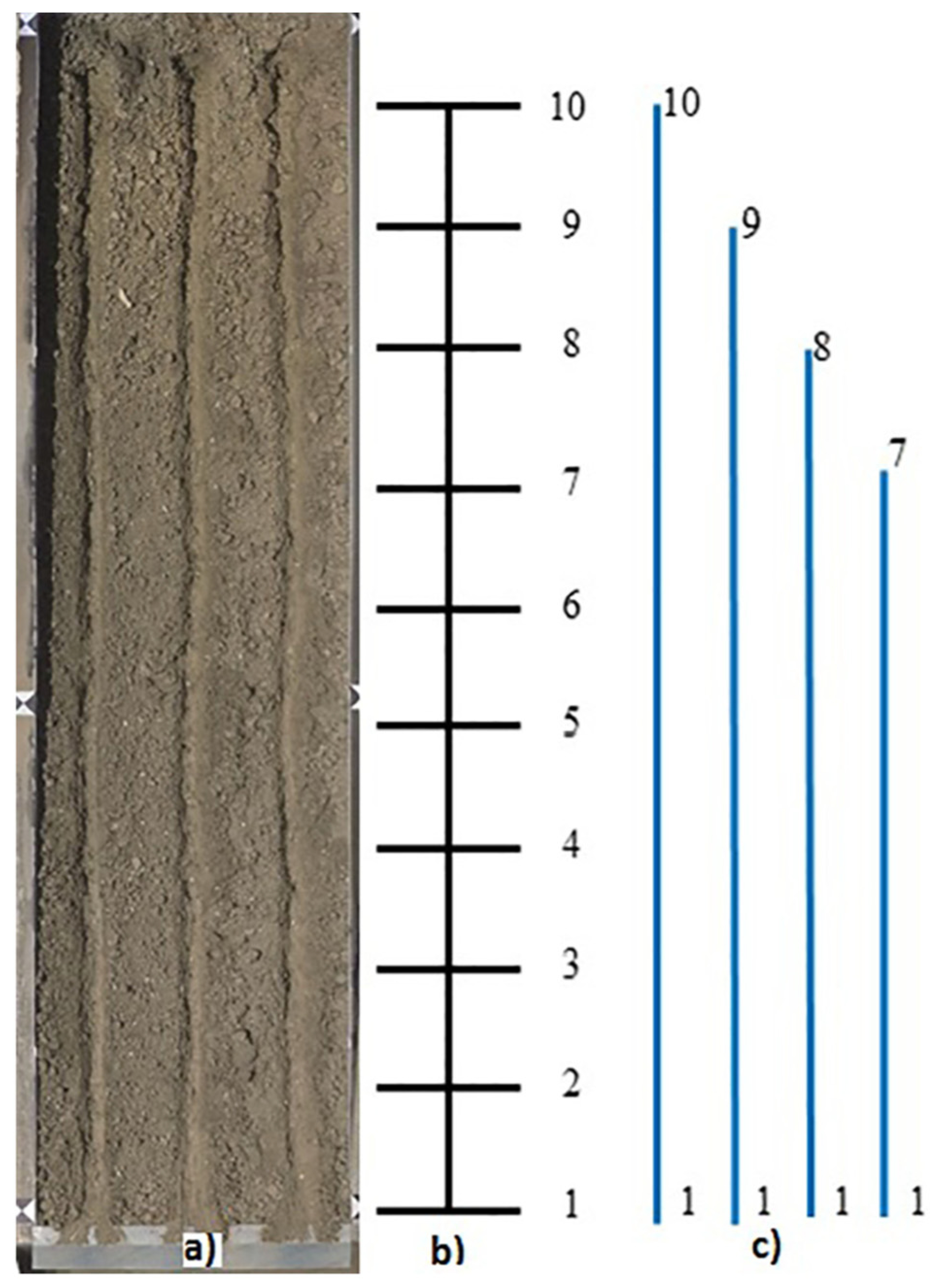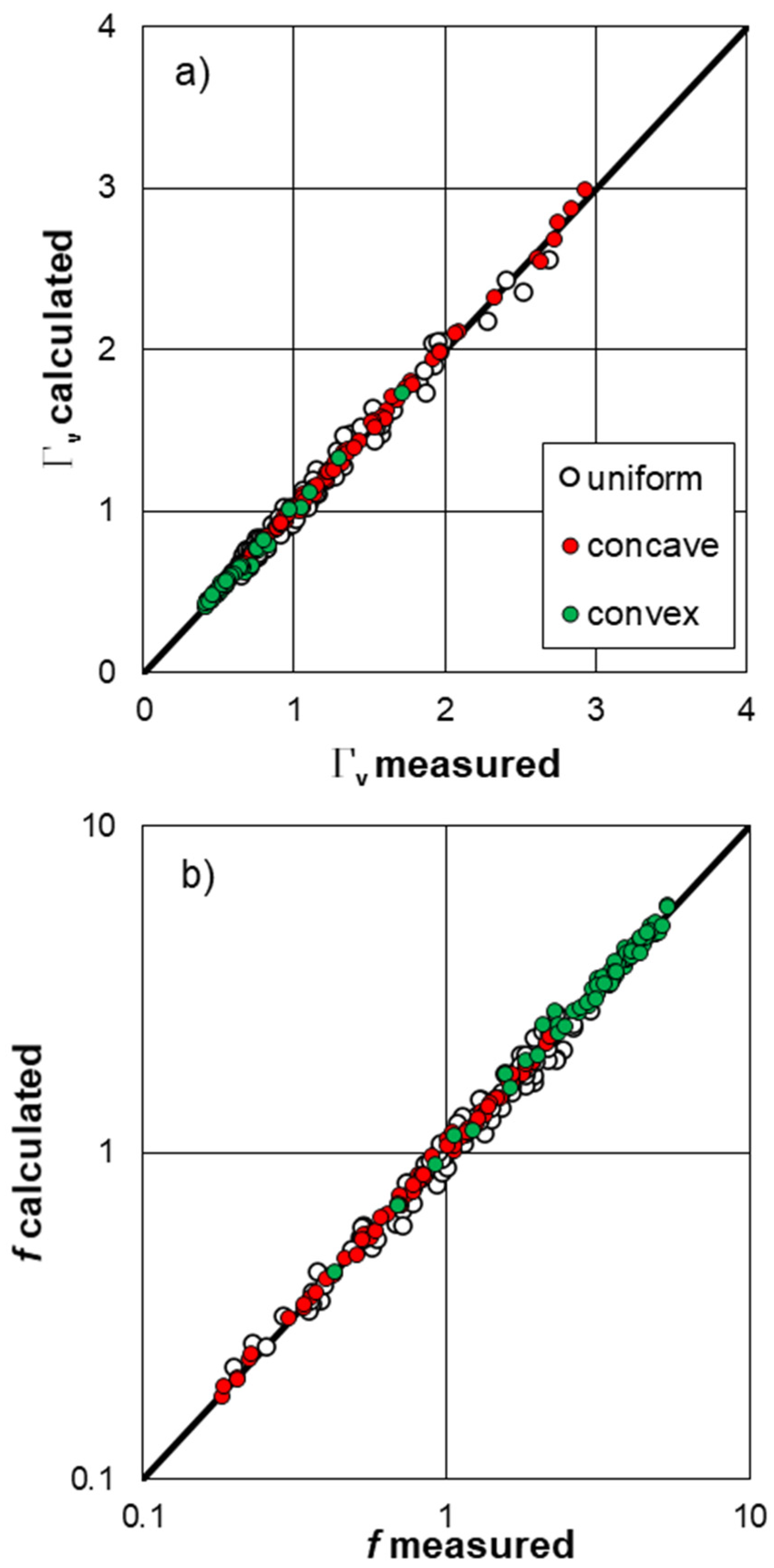Evaluating the Effects of the Rill Longitudinal Profile on Flow Resistance Law
Abstract
:1. Introduction
2. Materials and Methods
2.1. The Experimental Plots and Measurements
2.2. The Rill Flow Resistance Equation
3. Results
3.1. Rill Flow Resistance for Different Profile Shapes
3.2. Analysis of Rill Scour Depth and Eroded Volume for Different Profile Shapes
4. Discussion
4.1. Rill Flow Resistance for Different Profile Shapes
4.2. Analysis of Rill Scour Depth and Eroded Volume for Different Profile Shapes
5. Conclusions
Author Contributions
Funding
Data Availability Statement
Conflicts of Interest
References
- Liu, B.Y.; Nearing, M.A.; Risse, L.M. Slope Gradient Effects on Soil Loss for Steep Slopes. Trans. ASAE 1994, 37, 1835–1840. [Google Scholar] [CrossRef]
- Rieke-Zapp, D.; Nearing, M.A. Slope Shape Effects on Erosion: A Laboratory Study. Soil Sci. Soc. Am. J. 2005, 69, 1463–1471. [Google Scholar] [CrossRef]
- Young, R.A.; Mutchler, C.K. Effect of slope shape on erosion and runoff. Trans. Am. Soc. Agric. Eng. 1969, 12, 231–233. [Google Scholar]
- Young, R.A.; Mutchler, C.K. Soil movement on irregular slopes. Water Resour. Res. 1969, 5, 1084–1089. [Google Scholar] [CrossRef]
- Sensoy, H.; Kara, O. Slope shape effect on runoff and soil erosion under natural rainfall conditions. iForest 2014, 7, 110–114. [Google Scholar] [CrossRef] [Green Version]
- Jeldes, I.A.; Drumm, E.C.; Yoder, D.C. Design of Stable Concave Slopes for Reduced Sediment Delivery. J. Geotech. Geoenviron. Eng. 2015, 141, 04014093. [Google Scholar] [CrossRef]
- Williams, R.D.; Nicks, A.D. Using CREAMS to simulate filter strip effectiveness in erosion control. J. Soil Water Conserv. 1988, 43, 108–112. [Google Scholar]
- Hancock, G.R.; Loch, R.J.; Willgoose, G.R. The design of post-mining landscapes using geomorphic principles. Earth Surf. Process. Landf. 2003, 28, 1097–1110. [Google Scholar] [CrossRef]
- Mombini, A.; Amanian, N.; Talebi, A.; Kiani-Harchegani, M.; Rodrigo-Comino, J. Surface roughness effects on soil loss rate in complex hillslopes under laboratory conditions. Catena 2021, 206, 105503. [Google Scholar] [CrossRef]
- Frankl, A.; Stal, C.; Abraha, A.; Nyssen, J.; Rieke-Zapp, D.; De Wulf, A.; Poesen, J. Detailed recording of gully morphology in 3D through image-based modelling. Catena 2015, 127, 92–101. [Google Scholar] [CrossRef] [Green Version]
- Javernick, L.; Brasington, J.; Caruso, B. Modeling the topography of shallow braided rivers using Structure-from-Motion photogrammetry. Geomorphology 2014, 213, 166–182. [Google Scholar] [CrossRef]
- Seiz, S.M.; Curless, B.; Diebel, J.; Scharstein, D.; Szeliski, R. A comparison an evaluation of multi-view stereo reconstruction algorithms. In Proceedings of the 2006 IEEE Computer Society Conference on Computer Vision and Pattern Recognition (CVPR’06), New York, NY, USA, 17–22 June 2006. [Google Scholar]
- Di Stefano, C.; Ferro, V.; Palmeri, V.; Pampalone, V. Measuring rill erosion using structure from motion: A plot experiment. Catena 2017, 156, 383–392. [Google Scholar] [CrossRef]
- Mutchler, C.K.; Young, R.A. Soil detachment by raindrops. In Present and Prospective Technology for Prediction Sediment Yields and Sources; USDAARS Publication ARS-S-40: Beltsville, MD, USA, 1975; pp. 113–117. [Google Scholar]
- Zhang, P.; Tang, H.; Yao, W.; Zhang, N.; Xizhi, L.V. Experimental investigation of morphological characteristics of rill evolution on loess slope. Catena 2016, 137, 536–544. [Google Scholar] [CrossRef]
- Bagarello, V.; Ferro, V. Plot-scale measurements of soil erosion at the experimental area of Sparacia (southern Italy). Hydrol. Process. 2004, 18, 141–157. [Google Scholar] [CrossRef]
- Bagarello, V.; Ferro, V. Analysis of soil loss data from plots of different length for the Sparacia experimental area, Sicily, Italy. Byosyst. Eng. 2010, 105, 411–422. [Google Scholar] [CrossRef]
- Govers, G.; Giménez, R.; Van Oost, K. Rill erosion: Exploring the relationship between experiments, modeling and field observations. Earth Sci. Rev. 2007, 8, 87–102. [Google Scholar] [CrossRef]
- Bruno, C.; Di Stefano, C.; Ferro, V. Field investigation on rilling in the experimental Sparacia area, South Italy. Earth Surf. Process. Landf. 2008, 33, 263–279. [Google Scholar] [CrossRef]
- Bagarello, V.; Di Stefano, C.; Ferro, V.; Pampalone, V. Establishing a soil loss threshold for limiting rilling. J. Hydrol. Eng. 2015, 20, C6014001. [Google Scholar] [CrossRef]
- Di Stefano, C.; Ferro, V.; Pampalone, V.; Sanzone, F. Field investigation of rill and ephemeral gully erosion in the Sparacia experimental area, South Italy. Catena 2013, 101, 226–234. [Google Scholar] [CrossRef]
- Di Stefano, C.; Ferro, V.; Pampalone, V. Modeling rill erosion at the Sparacia experimental area. J. Hydrol. Eng. 2015, 20, C5014001. [Google Scholar] [CrossRef]
- Peng, W.; Zhang, Z.; Zhang, K. Hydrodynamic characteristics of rill flow on steep slopes. Hydrol. Process. 2015, 29, 3677–3686. [Google Scholar] [CrossRef]
- Iradukunda, P.; Bwambale, E. Reservoir sedimentation and its effect on storage capacity–A case study of Murera reservoir, Kenya. Cogent Eng. 2021, 8, 1. [Google Scholar] [CrossRef]
- Ferro, V. New flow resistance law for steep mountain streams based on velocity profile. J. Irrig. Drain. Eng. 2017, 143, 1–6. [Google Scholar] [CrossRef]
- Ferro, V. Assessing flow resistance in gravel bed channels by dimensional analysis and self-similarity. Catena 2018, 169, 119–127. [Google Scholar] [CrossRef]
- Di Stefano, C.; Ferro, V.; Palmeri, V.; Pampalone, V. Flow resistance equation for rills. Hydrol. Process. 2017, 31, 2793–2801. [Google Scholar] [CrossRef]
- Di Stefano, C.; Ferro, V.; Palmeri, V.; Pampalone, V. Testing slope effect on flow resistance equation for mobile bed rills. Hydrol. Process. 2018, 32, 664–671. [Google Scholar] [CrossRef]
- Di Stefano, C.; Nicosia, A.; Palmeri, V.; Pampalone, V.; Ferro, V. Comparing flow resistance law for fixed and mobile bed rills. Hydrol. Process. 2019, 33, 3330–3348. [Google Scholar] [CrossRef]
- Di Stefano, C.; Nicosia, A.; Palmeri, V.; Pampalone, V.; Ferro, V. Estimating flow resistance in steep slope rills. Hydrol. Process. 2021, 35, e14296. [Google Scholar] [CrossRef]
- Di Stefano, C.; Nicosia, A.; Palmeri, V.; Pampalone, V.; Ferro, V. Rill flow resistance law under equilibrium bed-load transport conditions. Hydrol. Process. 2019, 33, 1317–1323. [Google Scholar] [CrossRef]
- Ferro, V.; Nicosia, A. Comment on “Rill erosion processes on steep colluvial deposit slope under heavy rainfall in flume experiments with artificial rain by F. Jiang et al.”. Catena 2020, 185, 103–793. [Google Scholar] [CrossRef]
- Nicosia, A.; Di Stefano, C.; Pampalone, V.; Palmeri, V.; Ferro, V.; Nearing, M.A. Testing a new rill flow resistance approach using the water erosion prediction project experimental database. Hydrol. Process. 2019, 33, 616–626. [Google Scholar] [CrossRef]
- Palmeri, V.; Pampalone, V.; Di Stefano, C.; Nicosia, A.; Ferro, V. Experiments for testing soil texture effects on flow resistance in mobile bed rills. Catena 2018, 171, 176–184. [Google Scholar] [CrossRef]
- Carollo, F.G.; Di Stefano, C.; Nicosia, A.; Palmeri, V.; Pampalone, V.; Ferro, V. Flow resistance in mobile bed rills shaped in soils with different texture. Eur. J. Soil Sci. 2021, 72, 2062–2075. [Google Scholar] [CrossRef]
- Di Stefano, C.; Nicosia, A.; Pampalone, V.; Palmeri, V.; Ferro, V. New technique for measuring water depth in rill channels. Catena 2019, 181, 104090. [Google Scholar] [CrossRef]
- Line, D.E.; Meyer, L.D. Flow velocities of concentrated runoff along cropland furrows. Trans. ASAE 1988, 31, 1435–1439. [Google Scholar]
- Govers, G. Relationship between discharge, velocity and flow area for rills eroding loose, non-layered materials. Earth Surf. Process. Landf. 1992, 17, 515–528. [Google Scholar] [CrossRef]
- Abrahams, A.D.; Li, G.; Parsons, A.J. Rill hydraulics on a semiarid hillslope, southern Arizona. Earth Surf. Process. Landf. 1996, 21, 35–47. [Google Scholar] [CrossRef]
- Di Stefano, C.; Nicosia, A.; Palmeri, V.; Pampalone, V.; Ferro, V. Dye-tracer technique for rill flows by velocity profile measurements. Catena 2020, 185, 104313. [Google Scholar] [CrossRef]
- Luk, S.H.; Merz, W. Use of the salt tracing technique to determine the velocity of overland flow. Soil Technol. 1992, 5, 289–301. [Google Scholar]
- Li, G.; Abrahams, A.D. Effect of salting sediment load on the determination of the mean velocity of overland flow. Water Resour. Res. 1997, 33, 341–347. [Google Scholar] [CrossRef]
- Zhang, G.; Luo, R.; Cao, Y.; Shen, R.; Zhang, X.C. Correction factor to dye-measured flow velocity under varying water and sediment discharges. J. Hydrol. 2010, 389, 205–213. [Google Scholar] [CrossRef]
- Barenblatt, G.I. Dimensional Analysis; Gordon &Breach, Science Publishers Inc.: Amsterdam, The Netherlands, 1987. [Google Scholar]
- Barenblatt, G.I. Scaling laws for fully developed turbulent shear flows, part 1, Basic hypothesis and analysis. J. Fluid Mech. 1993, 248, 513–520. [Google Scholar] [CrossRef]
- Ferro, V. Applying hypothesis of self-similarity for flow-resistance law of small-diameter plastic pipes. J. Irrig. Drain. Eng. 1997, 123, 175–179. [Google Scholar] [CrossRef]
- Barenblatt, G.I.; Monin, A.S. Similarity laws for turbulent stratified flows. Arch. Ration. Mech. Anal. 1979, 70, 307–317. [Google Scholar] [CrossRef]
- Barenblatt, G.I.; Prostokishin, V.M. Scaling laws for fully developed turbulent shear flows, part 2. Processing of experimental data. J. Fluid Mech. 1993, 248, 521–529. [Google Scholar] [CrossRef]
- Butera, L.; Ridolfi, L.; Sordo, S. On the hypothesis of self-similarity for the velocity distribution in turbulent flows. Excerpta 1993, 8, 63–94. [Google Scholar]
- Ferro, V.; Pecoraro, R. Incomplete self-similarity and flow velocity in gravel bed channels. Water Resour. Res. 2000, 36, 2761–2770. [Google Scholar] [CrossRef] [Green Version]
- Castaing, B.; Gagne, Y.; Hopfinger, E.J. Velocity probability density functions of high Reynolds number turbulence. Phys. D 1990, 46, 177–200. [Google Scholar] [CrossRef]
- Barenblatt, G.I. On the scaling laws (incomplete self-similarity with respect to Reynolds numbers) for the developed turbulent flows in tubes. C. R. Acad. Sci. Ser. 1991, 313, 307–312. [Google Scholar]
- Ferro, V.; Porto, P. Applying hypothesis of self-similarity for flow resistance law in Calabrian gravel bed rivers (Fiumare). J. Hydraul. Eng. 2018, 144, 1–11. [Google Scholar] [CrossRef]
- Ferro, V. Assessing flow resistance law in vegetated channels by dimensional analysis and self-similarity. Flow Meas. Instrum. 2019, 69, 101610. [Google Scholar] [CrossRef]
- Yalin, M.S. Mechanics of Sediment Transport, 2nd ed.; Pergamon Press: Oxford, UK, 1977. [Google Scholar]
- Di Stefano, C.; Nicosia, A.; Palmeri, V.; Pampalone, V.; Ferro, V. Rill flow resistance law under sediment transport. J. Soils Sediments 2022, 22, 334–347. [Google Scholar] [CrossRef]
- Nicosia, A.; Bischetti, G.B.; Chiaradia, E.; Gandolfi, C.; Ferro, V. A Full-Scale study of Darcy-Weisbach friction factor for channels vegetated by riparian species. Hydrol. Process. 2021, 35, e14009. [Google Scholar] [CrossRef]
- Nicosia, A.; Palmeri, V.; Pampalone, V.; Di Stefano, C.; Ferro, V. Slope threshold in rill flow resistance. Catena 2022, 208, 105789. [Google Scholar] [CrossRef]















| Profile Shape | a | b | c |
|---|---|---|---|
| Uniform | 0.4419 | 1.0127 | 0.5224 |
| Concave | 0.4025 | 1.1084 | 0.5469 |
| Convex | 0.5187 | 1.0437 | 0.3795 |
Publisher’s Note: MDPI stays neutral with regard to jurisdictional claims in published maps and institutional affiliations. |
© 2022 by the authors. Licensee MDPI, Basel, Switzerland. This article is an open access article distributed under the terms and conditions of the Creative Commons Attribution (CC BY) license (https://creativecommons.org/licenses/by/4.0/).
Share and Cite
Nicosia, A.; Di Stefano, C.; Palmeri, V.; Pampalone, V.; Ferro, V. Evaluating the Effects of the Rill Longitudinal Profile on Flow Resistance Law. Water 2022, 14, 326. https://doi.org/10.3390/w14030326
Nicosia A, Di Stefano C, Palmeri V, Pampalone V, Ferro V. Evaluating the Effects of the Rill Longitudinal Profile on Flow Resistance Law. Water. 2022; 14(3):326. https://doi.org/10.3390/w14030326
Chicago/Turabian StyleNicosia, Alessio, Costanza Di Stefano, Vincenzo Palmeri, Vincenzo Pampalone, and Vito Ferro. 2022. "Evaluating the Effects of the Rill Longitudinal Profile on Flow Resistance Law" Water 14, no. 3: 326. https://doi.org/10.3390/w14030326






